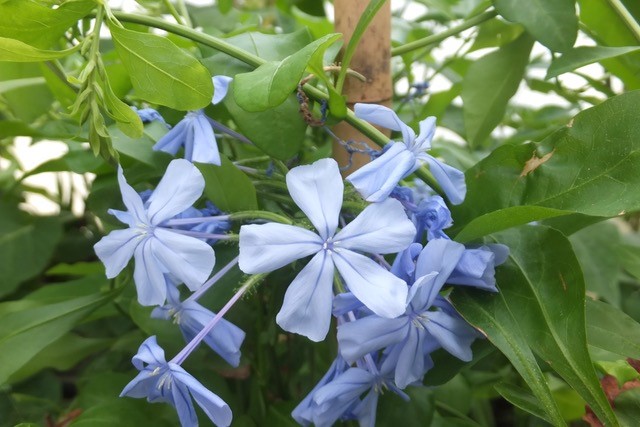
Not introduced into our greenhouses and conservatories till 1818 when it was brought from the Cape of Good Hope now known as South Africa. Leadwort, Plumbago, soon became very popular with Victorian gardeners. A lax climbing shrub this can bloom non-stop from the end of winter right through until winter returns again. Without doubt this has one of the longest flowering periods of any plants we cultivate and really is a ‘must have’.
Plumbago capensis, now P. auriculata, Leadwort, is tender and will die if frosted so needs a warm bright place -though does not like somewhere too hot and drying. A conservatory plant beyond compare and an excellent houseplant more suited for the bathroom windowsill rather than the living room if both are equally bright.
Theoretically Plumbago could go outdoors for the summer but would get battered by wind and rain so looks best under glass where it thrives and can reach a couple of metres if happy, indeed it can almost become invasive. Fortunately Plumbago can be pruned back (ideally when growth re-starts in Spring) but alternatively the longer shoots can be wound back in again making for a denser plant. (But as the flower trusses come on the ends of these shoots be sure to ensure these end back out in the light not buried inside.)
In theory you could start with seed however cuttings are easy anytime during the growing season, and far quicker. Plants are widely available and there are named varieties in different shades including a darker blue and a white, though neither are as gorgeous or floriferous as the original. The name Plumbago even comes from the leaden hue of these lovely Phlox-like flowers and has.

Plumbago is not picky as to compost and fairly easy going as to watering and feeding though may flag if neglected and should never be let dry out. So when growth is paused during winter the compost should carefully be kept just on the moist side but never wet. Neither is it prone to pests nor diseases other than the usual greenhouse suspects
If you appreciate the beauty of Plumbago there are up to twenty other species, mostly tropical, including the red flowering P. indica, for the connoisseur to find.










